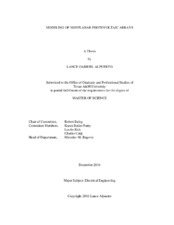| dc.contributor.advisor | Balog, Robert S | |
| dc.creator | Alpuerto, Lance Gabriel | |
| dc.date.accessioned | 2021-01-11T15:54:36Z | |
| dc.date.available | 2021-01-11T15:54:36Z | |
| dc.date.created | 2016-12 | |
| dc.date.issued | 2016-12-07 | |
| dc.date.submitted | December 2016 | |
| dc.identifier.uri | https://hdl.handle.net/1969.1/191959 | |
| dc.description.abstract | With the recent advancements of photovoltaic (PV) material, the previous limits of solar applications have been surpassed. These developing technologies allow for implementation on nonplanar surfaces. The implications of this advancement is the ability to harvest the abundance of solar energy in facets that were previously not possible, constrained by the rigidity of traditional crystalline silicon. Conventional modeling takes advantage of the homogenous nature of flat surface view factors for accurate clear sky harvest prediction. The issue arises when this homogeneity is no longer the case like a nonplanar surface, producing a gradient of view factors. These varying view factors also create new requirements for integration with power electronics responsible for converting raw PV current into usable energy and maximum harvest. Non-homogenous view factors create unique current densities on a per cell basis such that no longer allows the interconnection requirements of an array to be arbitrarily satisfied. This thesis takes a differential approach to modeling gradients of view factors and associated generated current densities on a nonplanar surface with the intention to geometrically optimize the surface cells to maximize harvest potential as well as create a means to determine the best cell interconnections for integration with current power electronic technologies. This work shows over 45% more energy collected in some geometries when compared to a flat plate. Also, a method for minimizing the current variability of cells to be connected in series was conducted. Using K-means clustering, each cell current is analyzed and grouped, resulting in appropriate results minimizing mismatch almost completely in some arrays. | en |
| dc.format.mimetype | application/pdf | |
| dc.language.iso | en | |
| dc.subject | Photovoltaic | en |
| dc.subject | solar | en |
| dc.subject | modeling | en |
| dc.subject | pixelization | en |
| dc.subject | cluster | en |
| dc.subject | maximum power point | en |
| dc.subject | view factor | en |
| dc.subject | radiation gradient | en |
| dc.subject | insolation | en |
| dc.subject | irradiation | en |
| dc.subject | k-means | en |
| dc.subject | MPPT | en |
| dc.subject | power electronics | en |
| dc.title | Modeling of Nonplanar Photovoltaic Arrays | en |
| dc.type | Thesis | en |
| thesis.degree.department | Electrical and Computer Engineering | en |
| thesis.degree.discipline | Electrical Engineering | en |
| thesis.degree.grantor | Texas A&M University | en |
| thesis.degree.name | Master of Science | en |
| thesis.degree.level | Masters | en |
| dc.contributor.committeeMember | Butler-Purry, Karen | |
| dc.contributor.committeeMember | Kish, Laszlo | |
| dc.contributor.committeeMember | Culp, Charles | |
| dc.type.material | text | en |
| dc.date.updated | 2021-01-11T15:54:37Z | |
| local.etdauthor.orcid | 0000-0001-8877-6855 | |


